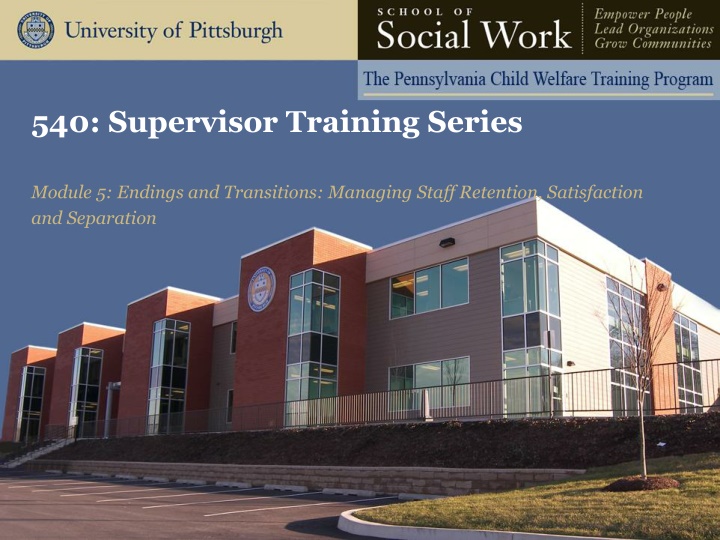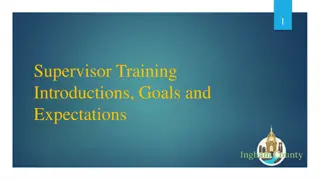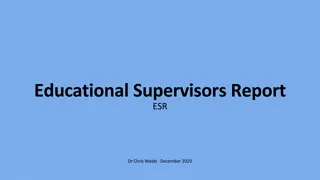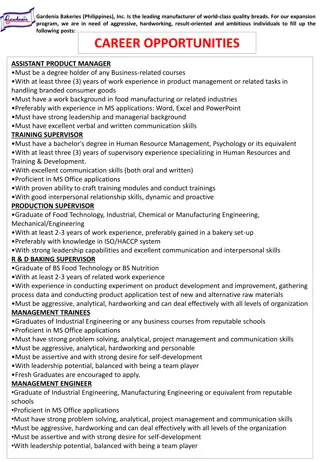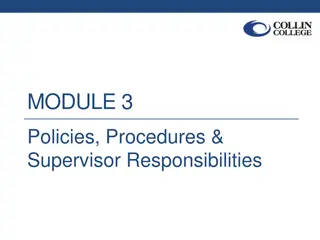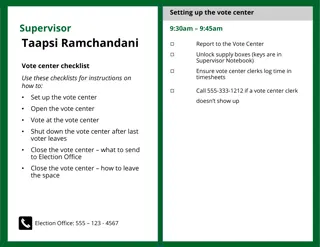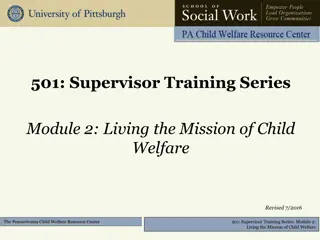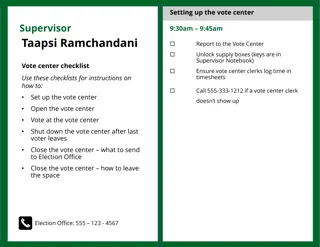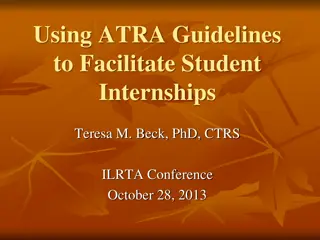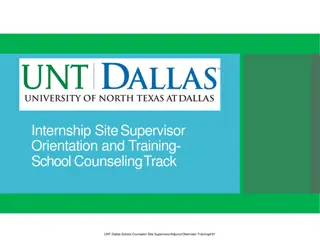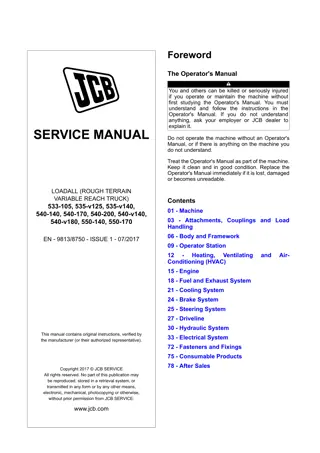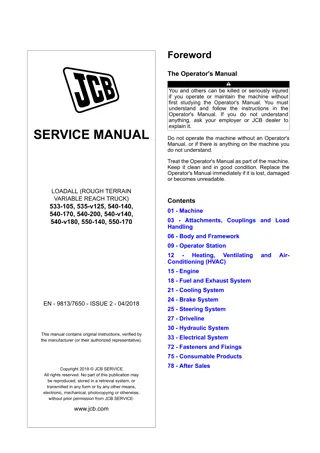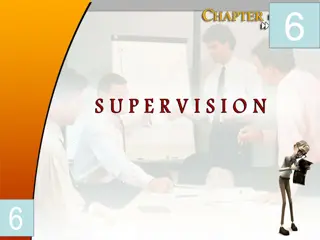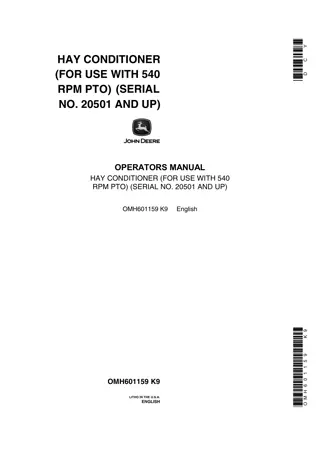540: Supervisor Training Series
Delve into ethical and effective strategies for managing staff endings and transitions in Module 5 of the Supervisor Training Series. Explore best practices in staff retention, satisfaction, and separation, while also focusing on self-care and professional growth. Gain insights into performance standards, disciplinary processes, and supervisory roles to ensure a supportive work environment. Develop a comprehensive plan for handling burnout and secondary traumatic stress effectively. Elevate your supervisory skills and enhance staff well-being with practical guidance and actionable steps.
Download Presentation

Please find below an Image/Link to download the presentation.
The content on the website is provided AS IS for your information and personal use only. It may not be sold, licensed, or shared on other websites without obtaining consent from the author.If you encounter any issues during the download, it is possible that the publisher has removed the file from their server.
You are allowed to download the files provided on this website for personal or commercial use, subject to the condition that they are used lawfully. All files are the property of their respective owners.
The content on the website is provided AS IS for your information and personal use only. It may not be sold, licensed, or shared on other websites without obtaining consent from the author.
E N D
Presentation Transcript
540: Supervisor Training Series Module 5: Endings and Transitions: Managing Staff Retention, Satisfaction and Separation
Learning Objectives Participants will be able to: Explore strategies to manage endings and transitions ethically and respectfully; Examine a continuous appraisal/quality improvement process to encourage best practice and ethical application of performance standards; Identify the steps in the disciplinary process; Identify the supervisor s role in ensuring staff employ self care; Develop the beginning of a plan for self-care; and Identify the next step in professional growth and development. The Pennsylvania Child Welfare Resource Center 540: Supervisor Training Series: Module 5: Endings and Transitions: Managing Staff Retention, Satisfaction and Separation 2
Supervisor Training Series The Preparatory and Beginning Phases of Child Welfare Supervision Living the Mission of Child Welfare The Middle/Work Phase of Supervision Managing Diversity Through the Employment Process Endings and Transitions/Managing Staff Retention, Satisfaction, and Separation The Pennsylvania Child Welfare Resource Center 540: Supervisor Training Series: Module 5: Endings and Transitions: Managing Staff Retention, Satisfaction and Separation 3
Roles of Supervision Administrative Supervision Educational Supervision Clinical Supervision The Pennsylvania Child Welfare Resource Center 540: Supervisor Training Series: Module 5: Endings and Transitions: Managing Staff Retention, Satisfaction and Separation 4
Agenda Section I: Introduction Section II: Desired Transitions Section III: Undesired Transitions Section IV: Burnout and Secondary Traumatic Stress: Why Do These Happen? Section V: Assessing Risk and Impact Section VI: Making a Secondary Trauma Action/Self Care Plan Section VII: The Organizational and Supervisory Roles Building on Prevention and Intervention Strategies Section VIII: The Next Step in Professional Growth and Development Section IX: Evaluations The Pennsylvania Child Welfare Resource Center 540: Supervisor Training Series: Module 5: Endings and Transitions: Managing Staff Retention, Satisfaction and Separation 5
What Are Desired Transitions? Lateral transfers Promotions CWEB/CWEL enrollment and graduation Leaves of absence Retirement Other voluntary resignations The Pennsylvania Child Welfare Resource Center 540: Supervisor Training Series: Module 5: Endings and Transitions: Managing Staff Retention, Satisfaction and Separation 6
If People Want Them, Why Worry? Competition for open positions; Lack of respect for newly-promoted managers; Problems with transitioning from co-workers to bosses; Difficulties in identifying and planning ahead for natural transitions; Problems when transitions occur for the wrong reason; and Work place morale can be negatively affected. The Pennsylvania Child Welfare Resource Center 540: Supervisor Training Series: Module 5: Endings and Transitions: Managing Staff Retention, Satisfaction and Separation 7
What Happens When More Than One Internal Employee Wants a Position? Be clear about what you are looking for from the start; Be clear about what knowledge, skills, abilities, and personalities are promotion; Be prepared to explain why you made your decision; and Support your choice. important to the The Pennsylvania Child Welfare Resource Center 540: Supervisor Training Series: Module 5: Endings and Transitions: Managing Staff Retention, Satisfaction and Separation 8
What is Succession Planning? In short, it means planning ahead for current employees transitions. Succession planning is a key part of overall workforce development, and forces employers to find, assess, develop, and monitor the workforce in a thoughtful way that best facilitates the organizational strategy. The Pennsylvania Child Welfare Resource Center 540: Supervisor Training Series: Module 5: Endings and Transitions: Managing Staff Retention, Satisfaction and Separation 9
Benefits of Succession Planning Plans for future organizational need before the need becomes pressing; Allows for the identification of talented candidates instead of forcing the employer to use whomever may be on hand; and Allows for the development and mentoring of talent. The Pennsylvania Child Welfare Resource Center 540: Supervisor Training Series: Module 5: Endings and Transitions: Managing Staff Retention, Satisfaction and Separation 10
Were Talking About One Key Person, Right? Succession planning is not just about one leader. We are talking about identifying those strategies and positions which are critical to the success of the organization. The Pennsylvania Child Welfare Resource Center 540: Supervisor Training Series: Module 5: Endings and Transitions: Managing Staff Retention, Satisfaction and Separation 11
CWEL Graduates Reported Increased Opportunities Some graduates reported increased opportunities for: challenging assignments; creativity; and promotions. (Cahalane and Sites, 2008) The Pennsylvania Child Welfare Resource Center 540: Supervisor Training Series: Module 5: Endings and Transitions: Managing Staff Retention, Satisfaction and Separation 12
CWEL Graduates Reported Concerns Some graduates report concerns such as: Lack of differentiation in job classifications among workers with and without graduate degrees; Lack of salary incentives; The Pennsylvania Child Welfare Resource Center 540: Supervisor Training Series: Module 5: Endings and Transitions: Managing Staff Retention, Satisfaction and Separation 13
CWEL Graduates Reported Concerns (continued) Hostile, skeptical and jealous reception workers sometimes face upon return to their agency after graduation; Difficulty of some in negotiating assignments that capitalize on the returning worker s new skills and advanced training; The Pennsylvania Child Welfare Resource Center 540: Supervisor Training Series: Module 5: Endings and Transitions: Managing Staff Retention, Satisfaction and Separation 14
CWEL Graduates Reported Concerns (continued) Scarcity of opportunities for promotion in some (perhaps many) counties; and The sense that advanced educational achievement is not matched with respect and leadership opportunities. (Cahalane and Sites, 2008) The Pennsylvania Child Welfare Resource Center 540: Supervisor Training Series: Module 5: Endings and Transitions: Managing Staff Retention, Satisfaction and Separation 15
CWEB Students When compared to CWEL students, CWEB students were generally: Younger; Had less years of work experience; and Reported less commitment to the field of child welfare. The Pennsylvania Child Welfare Resource Center 540: Supervisor Training Series: Module 5: Endings and Transitions: Managing Staff Retention, Satisfaction and Separation 16
Recommendations for Success from Successful Organizations Smooth transitions. The right developmental assignments. Meaningful appraisals and feedback. Appropriate selection criteria. A range of good choices. The Pennsylvania Child Welfare Resource Center 540: Supervisor Training Series: Module 5: Endings and Transitions: Managing Staff Retention, Satisfaction and Separation 17
Leaves of Absence The Family and Medical Leave Act (FMLA) The Americans with Disabilities Act (ADA) The Pennsylvania Child Welfare Resource Center 540: Supervisor Training Series: Module 5: Endings and Transitions: Managing Staff Retention, Satisfaction and Separation 18
The Americans with Disabilities Act Employers are obligated to provide employees with reasonable accommodations that will allow them to perform the essential functions of their jobs notwithstanding the fact that they have a disability. There is no perse limitation on how long an employee can be on leave pursuant to the ADA. The Pennsylvania Child Welfare Resource Center 540: Supervisor Training Series: Module 5: Endings and Transitions: Managing Staff Retention, Satisfaction and Separation 19
How Do I Get Employees on Board with Helping Out During a Leave? Tell other employees that the worker is on permitted leave; Be clear and honest with employees about the need for assistance and the reasons for it; Give details regarding how long the extrawork is expected to last; Ask them to put themselves in the shoes of the employee on leave; Let staff see that you are willing to put in extra work; and Appeal to the sense of teamwork. The Pennsylvania Child Welfare Resource Center 540: Supervisor Training Series: Module 5: Endings and Transitions: Managing Staff Retention, Satisfaction and Separation 20
Responding in the Face of Voluntary Resignations Initial Steps: Assess the reasons (stated and unstated) to determine how a resigning employee should be permitted to work for the remaining notice period; Determine early how client/customer contact will occur and who will be responsible for making those calls; and Have a timeline ready for the transition, with specific steps about how the departure will be handled. The Pennsylvania Child Welfare Resource Center 540: Supervisor Training Series: Module 5: Endings and Transitions: Managing Staff Retention, Satisfaction and Separation 21
What Are Undesired Transitions? Disciplines; Demotions; Negative Performance Evaluations; Suspensions; and Terminations. The Pennsylvania Child Welfare Resource Center 540: Supervisor Training Series: Module 5: Endings and Transitions: Managing Staff Retention, Satisfaction and Separation 22
Corrective Action Plan Created for employees who are not meeting minimum standards. Includes measurable goals for improvement. Require additional follow-up to monitor progress. Require interim evaluations. The Pennsylvania Child Welfare Resource Center 540: Supervisor Training Series: Module 5: Endings and Transitions: Managing Staff Retention, Satisfaction and Separation Slide 23 of 86
The Importance of Being Earnest Identifies undesirable behavior and gives an employee the opportunity to correct it; Serves as notice to the employee that their position may be in jeopardy if behavior does not change; and Allows the employee to foresee termination, suspension, or demotion. The Pennsylvania Child Welfare Resource Center 540: Supervisor Training Series: Module 5: Endings and Transitions: Managing Staff Retention, Satisfaction and Separation 24
The General Rule for Employment Under Pennsylvania common law, employment relationships are atwill, meaning an employer can terminate an employee, employment decision, for any reason or no reason at all. or make any other But The Pennsylvania Child Welfare Resource Center 540: Supervisor Training Series: Module 5: Endings and Transitions: Managing Staff Retention, Satisfaction and Separation 25
Common Law vs. Statute The Americans with Disabilities Act (ADA) The Age Discrimination in Employment Act (ADEA) Title VII of the Civil Rights Act of 1964 The Genetic Information Non-Discrimination Act (GINA) The Pregnancy Discrimination Act (PDA) The Family and Medical Leave Act (FMLA) The Pennsylvania Human Relations Act (PHRA) The Pennsylvania Whistleblower Act (PWA) The Pennsylvania Workers Compensation Act (PWCA) The Civil Rights Act Civil Service Laws Labor Laws The Pennsylvania Child Welfare Resource Center 540: Supervisor Training Series: Module 5: Endings and Transitions: Managing Staff Retention, Satisfaction and Separation 26
Legal Protections Gender; Race; An employee with a disability; Age; Sexual Orientation; Religion; An employee on FMLA; A pregnant employee; and Whistleblower (an employee who makes a good faith report or is about to report, verbally or in writing, to the employer or appropriate authority an instance of wrongdoing or waste by an employer.) The Pennsylvania Child Welfare Resource Center 540: Supervisor Training Series: Module 5: Endings and Transitions: Managing Staff Retention, Satisfaction and Separation 27
How Do They Affect My Decisions? Decisions based on an employee s membership in a protected class are prohibited under these statutes. Supervisors must be conscientious as to the reasons and support for each and every corrective or disciplinary action, as well as all termination, suspension, and demotion decisions. The Pennsylvania Child Welfare Resource Center 540: Supervisor Training Series: Module 5: Endings and Transitions: Managing Staff Retention, Satisfaction and Separation 28
Human Resources Trainings 535: Management of Conflict 540: Supervising through HIPAA, FMLA, and ADA and Privacy 540: The Disciplinary Process 703: Legal Issues to Consider in Making Hiring Decisions 703: The Employee Review Process 704: Legal Issues to Consider in Making Firing Decisions 501: The Employee Performance Review Process 533: Beyond the Evaluation: Managing Performance to Increase Caseworker Retentions and Job Satisfaction 533: Supervising Difficult Employees 534: Employee Performance Evaluation The Pennsylvania Child Welfare Resource Center 540: Supervisor Training Series: Module 5: Endings and Transitions: Managing Staff Retention, Satisfaction and Separation 29
Sample Progressive Discipline Policy The following progressive disciplinary system will be imposed when an employee violates a company rule or policy or has a significant performance problem: (1) VERBAL WARNING (2) WRITTEN WARNING (3) TERMINATION The Pennsylvania Child Welfare Resource Center 540: Supervisor Training Series: Module 5: Endings and Transitions: Managing Staff Retention, Satisfaction and Separation 30
The Legitimate, Nondiscriminatory Reason The way to avoid lawsuits is to make termination, suspension, and demotion decisions for legitimate, nondiscriminatory reasons. following: Attendance problems; Performance issues; and Other disciplinary issues. These include the The Pennsylvania Child Welfare Resource Center 540: Supervisor Training Series: Module 5: Endings and Transitions: Managing Staff Retention, Satisfaction and Separation 31
What Is HIPAA? HIPAA is a federal law that sets rules and limitations on who can disclose what medical information regarding individuals and when. Medical information includes any record/letter regarding mental health treatment, substance abuse treatment, physical therapy, hospital visits, doctor visits, etc. The Pennsylvania Child Welfare Resource Center 540: Supervisor Training Series: Module 5: Endings and Transitions: Managing Staff Retention, Satisfaction and Separation 32
Protection and Confidentiality of Medical Information Medical information must be kept confidential even if it does not contain a medical diagnosis or treatment course or is not generated by a health care professional. Keep medical information in a separate file from regular personnel files that is only accessible to designated officials. The Pennsylvania Child Welfare Resource Center 540: Supervisor Training Series: Module 5: Endings and Transitions: Managing Staff Retention, Satisfaction and Separation 33
My Employees Keep Asking What Happened to John Doe Only if no employer policy around disclosure exists: Do not shy away from the question uncertainty and a lack of communication fosters gossip that may be worse than the actual truth; Be sensitive to how any information you may give regarding the separation could impact the departing employee s reputation and/or feelings toward the agency; and Do not give the whole truth with all the gory details. The Pennsylvania Child Welfare Resource Center 540: Supervisor Training Series: Module 5: Endings and Transitions: Managing Staff Retention, Satisfaction and Separation 34
No One is Talking to Me, But They Are Talking to Each Other Rootproblems that foster gossip in the workplace: Lack of communication from management, whether it involves good or bad information; Employee ignorance of the consequences of gossip; Lack of respect for management, and/or enforcement of rules by management Competition among employees; Cliques that are allowed to form and congregate regularly; Hesitance by employees to complain about the effects of rumor-mongering; and Uncertainty in the workplace. The Pennsylvania Child Welfare Resource Center 540: Supervisor Training Series: Module 5: Endings and Transitions: Managing Staff Retention, Satisfaction and Separation 35
Managing Gossip Define what gossip means to your agency, and impose rules based on that definition; Reinforce the policy regarding gossip in the workplace regularly with employees; Use performance appraisals to address questions of gossip that do not reach the disciplinary levels.; Assign more work; Educate employees on how they prevent rumors about themselves; and Go through the DAPIM problems (APHSA, 2009). process and address the root The Pennsylvania Child Welfare Resource Center 540: Supervisor Training Series: Module 5: Endings and Transitions: Managing Staff Retention, Satisfaction and Separation 36
What Happens If I Get a Reference Call? Employers are immune from defamation claims for providing information to a prospective employer regarding job performance, unless the employee can show by clear and convincing evidence that the employer: Disclosed information that they knew was false or should have known was false; Knowingly disclosed materially misleading information; Recklessly disclosed false information; or Disclosed information the disclosure of which was prohibited by law. The Pennsylvania Child Welfare Resource Center 540: Supervisor Training Series: Module 5: Endings and Transitions: Managing Staff Retention, Satisfaction and Separation 37
What Happens If I Get a Reference Call? (continued) Confirm dates of employment, job title, and rate of pay. Eligibility for rehire. Negotiate with the employee regarding a standard reference letter to be provided in response to a reference request. The Pennsylvania Child Welfare Resource Center 540: Supervisor Training Series: Module 5: Endings and Transitions: Managing Staff Retention, Satisfaction and Separation 38
Roles of Supervision Administrative Supervision Educational Supervision Clinical Supervision The Pennsylvania Child Welfare Resource Center 540: Supervisor Training Series: Module 5: Endings and Transitions: Managing Staff Retention, Satisfaction and Separation 39
Burnout and Secondary Trauma - Whats the Difference? Both issues have similar roots. Both issues involve the cumulative effects of stress. Both issues elicit similar responses from affected employees. While secondary trauma deals with secondary exposure to clients trauma, burnout adds the daily stressors of functioning in the overall workplace. The Pennsylvania Child Welfare Resource Center 540: Supervisor Training Series: Module 5: Endings and Transitions: Managing Staff Retention, Satisfaction and Separation 40
Endings and Transitions/Managing Staff Retention, Satisfaction and Separation The fact is that people are good. Give people affection and security, and they will give affection and be secure in their feelings and their behavior. - Abraham Maslow The Pennsylvania Child Welfare Resource Center 540: Supervisor Training Series: Module 5: Endings and Transitions: Managing Staff Retention, Satisfaction and Separation 41
What is This? Our exposure to secondary trauma is a process that occurs from ongoing, repeated exposure to trauma, suffering and tragedy. The effect will be cumulative, like exposure to radiation. It happens to employees as they are exposed to cruelty, grief and loss over time. It creates discernable changes in the employees in their physical health, psychological health and spiritual well being. The Pennsylvania Child Welfare Resource Center 540: Supervisor Training Series: Module 5: Endings and Transitions: Managing Staff Retention, Satisfaction and Separation 42
Why Does This Happen? Secondary trauma occurs because your employees care about those they serve. The employees feel committed to and responsible for helping those they serve. Secondary trauma occurs because the employee s long-held beliefs about institutional justice, religion and/or personal vulnerability are placed under attack. The Pennsylvania Child Welfare Resource Center 540: Supervisor Training Series: Module 5: Endings and Transitions: Managing Staff Retention, Satisfaction and Separation 43
Who is Most at Risk? People who tend to avoid problems or difficult feelings; Employees who have personally experienced trauma; People whose work is their whole life; People with no strong social support network; People with increased exposure to intense traumatic stress (primary or secondary); The Pennsylvania Child Welfare Resource Center 540: Supervisor Training Series: Module 5: Endings and Transitions: Managing Staff Retention, Satisfaction and Separation 44
Who is Most at Risk? (continued) People without a strong sense of purpose, hope or meaning in their lives; People experiencing high levels of stress/other problems in their lives; Inexperienced humanitarian workers; and Those who actively engage children and families in their work. The Pennsylvania Child Welfare Resource Center 540: Supervisor Training Series: Module 5: Endings and Transitions: Managing Staff Retention, Satisfaction and Separation 45
The Impact of Secondary Traumatic Stress What Happens to You (and your Employees)? Physical / Psychological Symptoms Worldview frame of reference changes Behavioral and relationship changes Job Performance The Pennsylvania Child Welfare Resource Center 540: Supervisor Training Series: Module 5: Endings and Transitions: Managing Staff Retention, Satisfaction and Separation 46
How Exposure to Secondary Traumatic Stress Affects Others Family Friends Work / coworkers Its not just all about you The Pennsylvania Child Welfare Resource Center 540: Supervisor Training Series: Module 5: Endings and Transitions: Managing Staff Retention, Satisfaction and Separation 47
Assessing the Impact on Those that Support Us Have you noticed the way I behave and appear to be different when I m under pressure? Do I seem to be acting that way increasingly more and more of the time? What ways do you think my work is impacting me during the last week or year? From your point of view, how does this impact you or other people that I care about? The Pennsylvania Child Welfare Resource Center 540: Supervisor Training Series: Module 5: Endings and Transitions: Managing Staff Retention, Satisfaction and Separation 48
Assessing Risk and Impact The Professional Quality of Life Scale (PROQOL) B. Hudnall Stamm The Pennsylvania Child Welfare Resource Center 540: Supervisor Training Series: Module 5: Endings and Transitions: Managing Staff Retention, Satisfaction and Separation 49
Making a Secondary Trauma Action/Self Care Plan Understanding the three areas of focus will enable us to develop successful strategies for coping with and transforming secondary trauma. They are: External locus of control Internal locus of control Support systems The Pennsylvania Child Welfare Resource Center 540: Supervisor Training Series: Module 5: Endings and Transitions: Managing Staff Retention, Satisfaction and Separation 50
